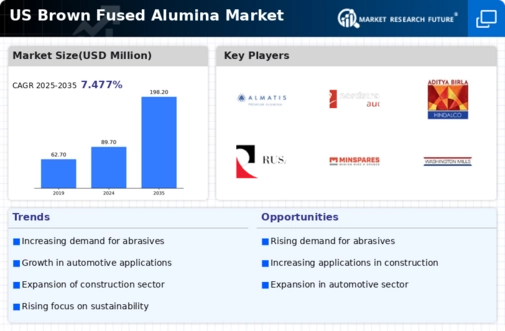The US Brown Fused Alumina Market is characterized by a dynamic and competitive landscape, driven by various factors including technological advancements, production techniques, and growing applications in multiple sectors such as abrasives, ceramics, and refractories. This market has seen an array of players who are continuously innovating and refining their manufacturing processes to meet the rising demand for high-purity and performance-oriented materials. Competition is not solely based on pricing but also hinges on quality, sustainability practices, and customer relationships, making the landscape quite intricate.
The increasing emphasis on high-performance products is pushing companies to enhance their technical capabilities while responding effectively to market trends and customer preferences. As demand continues to grow in construction, automotive, and metalworking sectors, companies are strategically positioning themselves to leverage future opportunities.Carborundum Universal Limited has established a robust presence in the US Brown Fused Alumina Market, recognized for its high-quality products and commitment to innovation. The company has a comprehensive portfolio of brown fused alumina offerings that cater to various industrial applications, emphasizing superior performance and durability.
One of the standout strengths of Carborundum Universal Limited is its extensive research and development capabilities, which enable the firm to stay ahead of market trends and to continuously enhance product formulations. Additionally, the company's strong distribution network in the US ensures that it can meet customer demands with efficiency and speed, further solidifying its competitive position.
The integration of sustainable practices in its operations also resonates well with the market trend towards eco-conscious manufacturing processes, making Carborundum Universal Limited a preferred choice among customers in the sector.Almatis plays a significant role in the US Brown Fused Alumina Market, being known for its focus on quality and innovation in its product offerings. The company specializes in a range of key products and services, including high-purity brown fused alumina, which positions it effectively within the competitive landscape.
Almatis boasts a strong market presence, supported by its commitment to research and development that drives the continuous improvement of its offerings. One of the notable strengths of Almatis is its strategic approach which includes expansions and partnerships aimed at bolstering its market footprint. The company's proactive strategy in mergers and acquisitions enhances its capacity to adapt and innovate, thereby addressing the varying needs of its diverse customer base in the US.
This adaptability and focus on quality also allow Almatis to maintain a leading edge in an increasingly competitive market environment, catering to industries such as refractories, ceramics, and abrasives effectively.


















Leave a Comment